Closing the Gap between Climate Information Producers and Users: Assessment of Needs and Uptake in Senegal
Abstract
1. Introduction
2. Materials and Methods
2.1. Characteristics of the Study Zone
2.2. Methodological Approach
2.2.1. Needs Assessments and End-User Engagement
2.2.2. Evaluation of CIS Uptake among Exposers
3. Results
3.1. CIS Needed vs. CIS Produced
3.2. CIS Diffusion Channels vs. Channels Developed
3.3. MWGs Created vs. MWGs’ Functionality
3.4. Magnitude of the Trainings on the Ground
3.5. CIS Uptake on the Ground
3.6. Difficulties Encountered
4. Discussion
4.1. Participatory Training as Way to Building Trust with the CIS Users
4.2. Building the Policy Enabling Environment
4.3. Challenges and Opportunities of CIS Upscaling
5. Conclusions
Acknowledgments
Author Contributions
Conflicts of Interest
References
- Niang, I.; Ruppel, O.; Abdrabo, M.; Essel, A.; Lennard, C.; Padgham, J.; Urquhart, P. Africa. In Climate Change 2014: Impacts, Adaptation and Vulnerability. Contribution of Working Group II to the Fifth Assessment Report of the Intergovernmental Panel on Climate Change; Cambridge University Press: Cambridge, UK, 2014. [Google Scholar]
- IPCC. Summary for Policymakers. In Climate Change 2014: Impacts, Adaptation, and Vulnerability. Part A: Global and Sectoral Aspects. Contribution of Working Group II to the Fifth Assessment Report of the Intergovermental Panel on Climate Change; Cambridge University Press: Cambridge, UK, 2014; pp. 1–32. [Google Scholar]
- Serdeczny, O.; Adams, S.; Baarsch, F.; Coumou, D.; Robinson, A.; Hare, W.; Schaeffer, M.; Perrette, M.; Reinhardt, J. Climate change impacts in sub-Saharan Africa: From physical changes to their social repercussions. Reg. Environ. Chang. 2017, 17, 1585–1600. [Google Scholar] [CrossRef]
- Jalloh, A.; Nelson, G.C.; Thomas, T.S.; Zougmoré, R.; Roy-Macauley, H. West African Agriculture and Climate Change: A Comprehensive Analysis. IFPRI Research Monograph; International Food Policy Research Institute: Washington, DC, USA, 2013. [Google Scholar]
- Aich, V.; Koné, B.; Hattermann, F.F.; Müller, E.N. Floods in the Niger basin—Analysis and attribution. Nat. Hazards Earth Syst. Sci. Discuss. 2014, 2, 5171–5212. [Google Scholar] [CrossRef]
- Rosenzweig, C.; Elliott, J.; Deryng, D.; Ruane, A.C.; Müller, C.; Arneth, A.; Boote, K.J.; Folberth, C.; Glotter, M.; Khabarov, N.; et al. Assessing agricultural risks of climate change in the 21st century in a global gridded crop model intercomparison. PNAS 2014, 111, 3268–3273. [Google Scholar]
- UNDESA. Volume I: Comprehensive Tables. In World Population Prospects: The 2012 Revision; UN Department of Economic and Social Affairs (UNDESA): New York, NY, USA, 2013. [Google Scholar]
- Mueller, N.D.; Gerber, J.S.; Johnston, M.; Ray, D.K.; Ramankutty, N.; Foley, J.A. Closing yield gaps through nutrient and water management. Nature 2012, 490, 254. [Google Scholar] [CrossRef] [PubMed]
- Ouedraogo, I.; Runge, J.; Eisenberg, J.; Barron, J.; Sawadogo-Kaboré, S. The re-greening of the Sahel: Natural cyclicity or human-induced change? Land 2014, 3, 1075. [Google Scholar] [CrossRef]
- Ouedraogo, I.; Barron, J.; Tumbo, S.D.; Kahimba, F.C. Land cover transition in northern Tanzania. Land Degrad. Dev. 2016, 27, 682–692. [Google Scholar] [CrossRef]
- Douxchamps, S.; Ayantunde, A.; Barron, J. Taking stock of forty years of agricultural water management interventions in smallholder systems of Burkina Faso. Water Resour. Rural Dev. 2014, 3, 1–13. [Google Scholar] [CrossRef]
- Barron, J.; Okwach, G. Run-off water harvesting for dry spell mitigation in maize (Zea mays L.): Results from on-farm research in semi-arid Kenya. Agric. Water Manag. 2005, 1–21. [Google Scholar] [CrossRef]
- De Bruin, A.; Pateman, R.; Barron, J.; Balima, M.; Ouedraogo, I.; Da Dapola, E.; Fosu, M.; Annor, F.O.; Magombeyi, M.; Kileshye Onema, J.-M. Setting up agricultural water management interventions—Learning from successful case studies in the Volta and Limpopo river basins. Water Resour. Rural Dev. 2015, 6, 12–23. [Google Scholar] [CrossRef]
- Rockstrom, J. Water resources management in smallholder farms in eastern and southern Africa: An overview. Phys. Chem. Earth Part B Hydrol. Ocean. Atmos. 2000, 25, 275–283. [Google Scholar] [CrossRef]
- Hackenbruch, J.; Kunz-Plapp, T.; Müller, S.; Schipper, J. Tailoring climate parameters to information needs for local adaptation to climate change. Climate 2017, 5, 25. [Google Scholar] [CrossRef]
- Vincent, K.; Dougill, A.J.; Dixon, J.L.; Stringer, L.C.; Cull, T. Identifying climate services needs for national planning: Insights from Malawi. Climate Policy 2017, 17, 189–202. [Google Scholar] [CrossRef]
- Singh, C.; Daron, J.; Bazaz, A.; Ziervogel, G.; Spear, D.; Krishnaswamy, J.; Zaroug, M.; Kituyi, E. The utility of weather and climate information for adaptation decision-making: Current uses and future prospects in Africa and India. Climate Dev. 2017. [Google Scholar] [CrossRef]
- Kusangaya, S.; Warburton, M.L.; Archer van Garderen, E.; Jewitt, G.P.W. Impacts of climate change on water resources in southern Africa: A review. Phys. Chem. Earth Part A/B/C 2014, 67–69, 47–54. [Google Scholar] [CrossRef]
- Vaughan, C.; Dessai, S. Climate services for society: Origins, institutional arrangements, and design elements for an evaluation framework. Wiley Interdiscip. Rev. Climate Chang. 2014, 5, 587–603. [Google Scholar] [CrossRef] [PubMed]
- UNPP. New Vision for Weather and Climate Information Services in Africa; United Nations Development Programme: New York, NY, USA, 2016. [Google Scholar]
- Zongo, B.; Diarra, A.; Barbier, B.; Zorom, M.; Yacouba, H.; Dogot, T. Farmers’ perception and willingness to pay for climate information in Burkina Faso. J. Agric. Sci. 2015. [Google Scholar] [CrossRef]
- Singh, C.; Dorward, P.; Osbahr, H. Developing a holistic approach to the analysis of farmer decision-making: Implications for adaptation policy and practice in developing countries. Land Use Policy 2016, 59, 329–343. [Google Scholar] [CrossRef]
- Lemos, M.C.; Kirchhoff, C.J.; Ramprasad, V. Narrowing the climate information usability gap. Nature Climate Chang. 2012, 2, 789. [Google Scholar] [CrossRef]
- Akinnagbe, O.M.; Irohibe, I.J. Agricultural adaptation strategies to climate change impacts in Africa: A review. Bangladesh J. Agric. Res. 2014, 39, 407–418. [Google Scholar] [CrossRef]
- Mbow, C.; Smith, P.; Skole, D.; Duguma, L.; Bustamante, M. Achieving mitigation and adaptation to climate change through sustainable agroforestry practices in Africa. Curr. Opin. Environ. Sustain. 2014, 6, 8–14. [Google Scholar] [CrossRef]
- Zougmoré, R.; Partey, S.; Ouédraogo, M.; Omitoyin, B.; Thomas, T.; Ayantunde, A.; Ericksen, P.; Said, M.; Jalloh, A. Toward climate-smart agriculture in west Africa: A review of climate change impacts, adaptation strategies and policy developments for the livestock, fishery and crop production sectors. Agric. Food Secur. 2016, 5, 26. [Google Scholar] [CrossRef]
- FAO. Senegal: Country Fact Sheet on Food and Agriculture Trends; FAO: Rome, Italy, 2015. [Google Scholar]
- CIAT; BFS/USAID. Climate-Smart Agriculture in Senegal. CSA Country Profiles for Africa Series; International Center for Tropical Agriculture (CIAT), Bureau for food security, United States Agency for International Development (BFS/USAID): Washington, DC, USA, 2016. [Google Scholar]
- Colen, L.; Demont, M.; Swinnen, J. Smallholder participation in value chains: The case of domestic rice in Senegal. In Rebuilding West Africa’s Food Potential; Elbehri, A., Ed.; FAO/IFAD: Rome, Italy, 2013. [Google Scholar]
- APRAPAM. Pêche : Oumar guèye annonce la construction de 19 unités de transformation. Available online: http://www.Aprapam.Org/senegal/securite-en-mer/ (accessed on 12 December 2017).
- Pontius, J.; Dilts, R.; Bartlett, A. From Farmer Field School to Community IPM: Ten Years of IPM Training in Asia; FAO: Bangkok, Thailand, 2002; p. 110. [Google Scholar]
- Eisenack, K.; Moser, S.C.; Hoffmann, E.; Klein, R.J.T.; Oberlack, C.; Pechan, A.; Rotter, M.; Termeer, C.J.A.M. Explaining and overcoming barriers to climate change adaptation. Nature Climate Chang. 2014, 4, 867. [Google Scholar] [CrossRef]
- Rose, D.C. Five ways to enhance the impact of climate science. Nature Climate Chang. 2014, 4, 522. [Google Scholar] [CrossRef]
- Kniveton, D.; Visman, E.; Tall, A.; Diop, M.; Ewbank, R.; Njoroge, E.; Pearson, L. Dealing with uncertainty: Integrating local and scientific knowledge of the climate and weather. Disasters 2015, 39, S35–S53. [Google Scholar] [CrossRef] [PubMed]
- Martínez, R.; Hemming, D.; Malone, L.; Bermudez, N.; Cockfield, G.; Diongue, A.; Hansen, J.; Hildebrand, A.; Ingram, K.; Jakeman, G.; et al. Improving climate risk management at local level—Techniques, case studies, good practices and guidelines for world meteorological organization members. In Risk Management–Current Issues and Challenges; Nerija, B., Ed.; InTechOpen: University Campus STeP Ri, Croatia, 2012. [Google Scholar]
- Demeritt, D.; Langdon, D. The UK climate change programme and communication with local authorities. Glob. Environ. Chang. 2004, 14, 325–336. [Google Scholar] [CrossRef]
- Mase, A.S.; Prokopy, L.S. Unrealized potential: A review of perceptions and use of weather and climate information in agricultural decision making. Weather Climate Soc. 2014, 6, 47–61. [Google Scholar] [CrossRef]
- Lackstrom, K.; Kettle, N.P.; Haywood, B.; Dow, K. Climate-sensitive decisions and time frames: A cross-sectoral analysis of information pathways in the Carolinas. Weather Climate Soc. 2014, 6, 238–252. [Google Scholar] [CrossRef]
- Nidumolu, U.B.; Lubbers, M.; Kanellopoulos, A.; van Ittersum, M.K.; Kadiyala, D.M.; Sreenivas, G. Engaging farmers on climate risk through targeted integration of bio-economic modelling and seasonal climate forecasts. Agric. Sys. 2016, 149, 175–184. [Google Scholar] [CrossRef]
- Dorward, P.; Clarkson, G.; Stern, R. Participatory Integrated Climate Services for Agriculture (PICSA): Field Manual; Walker Institute, University of Reading: Reading, UK, 2015. [Google Scholar]
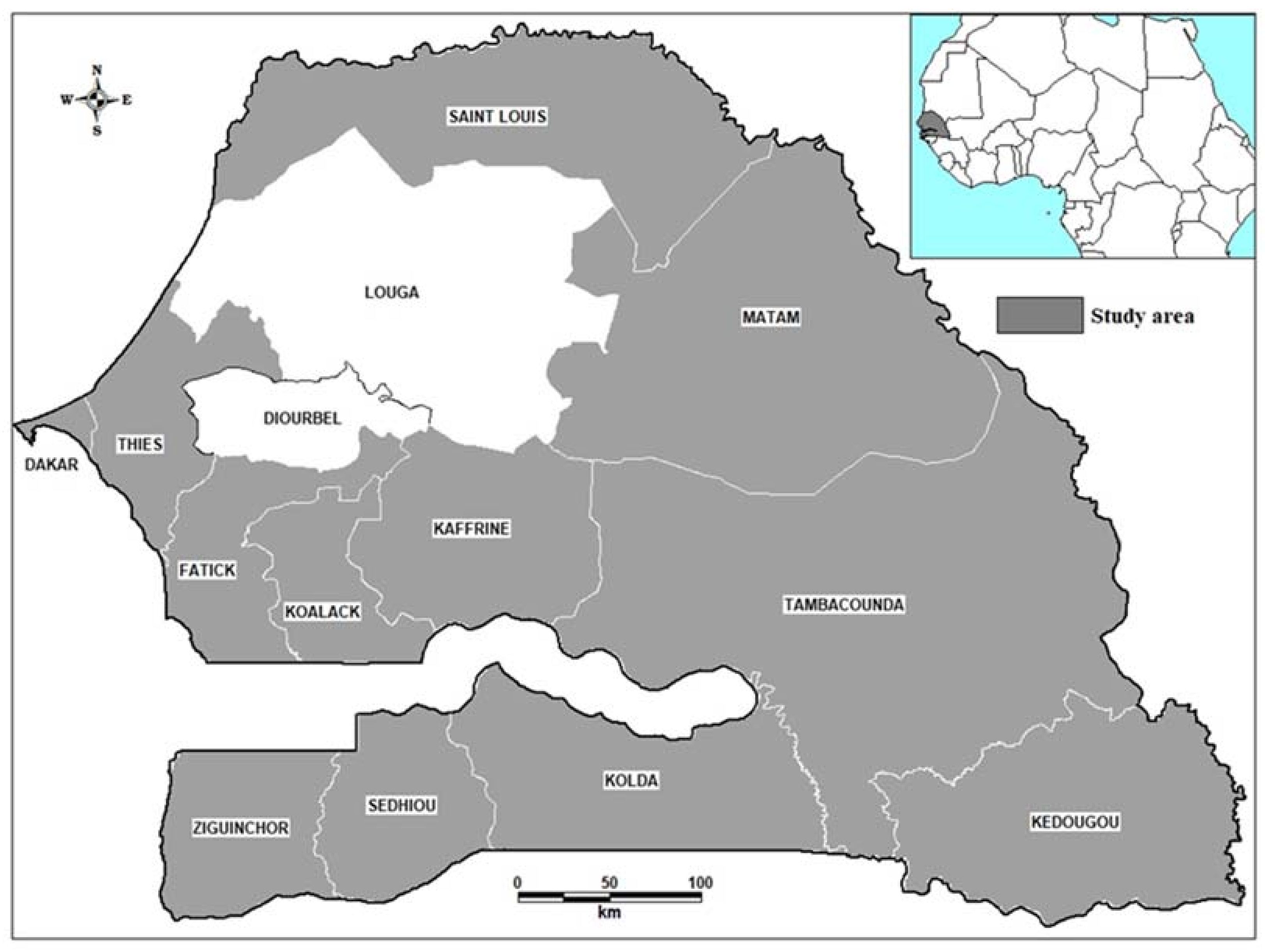
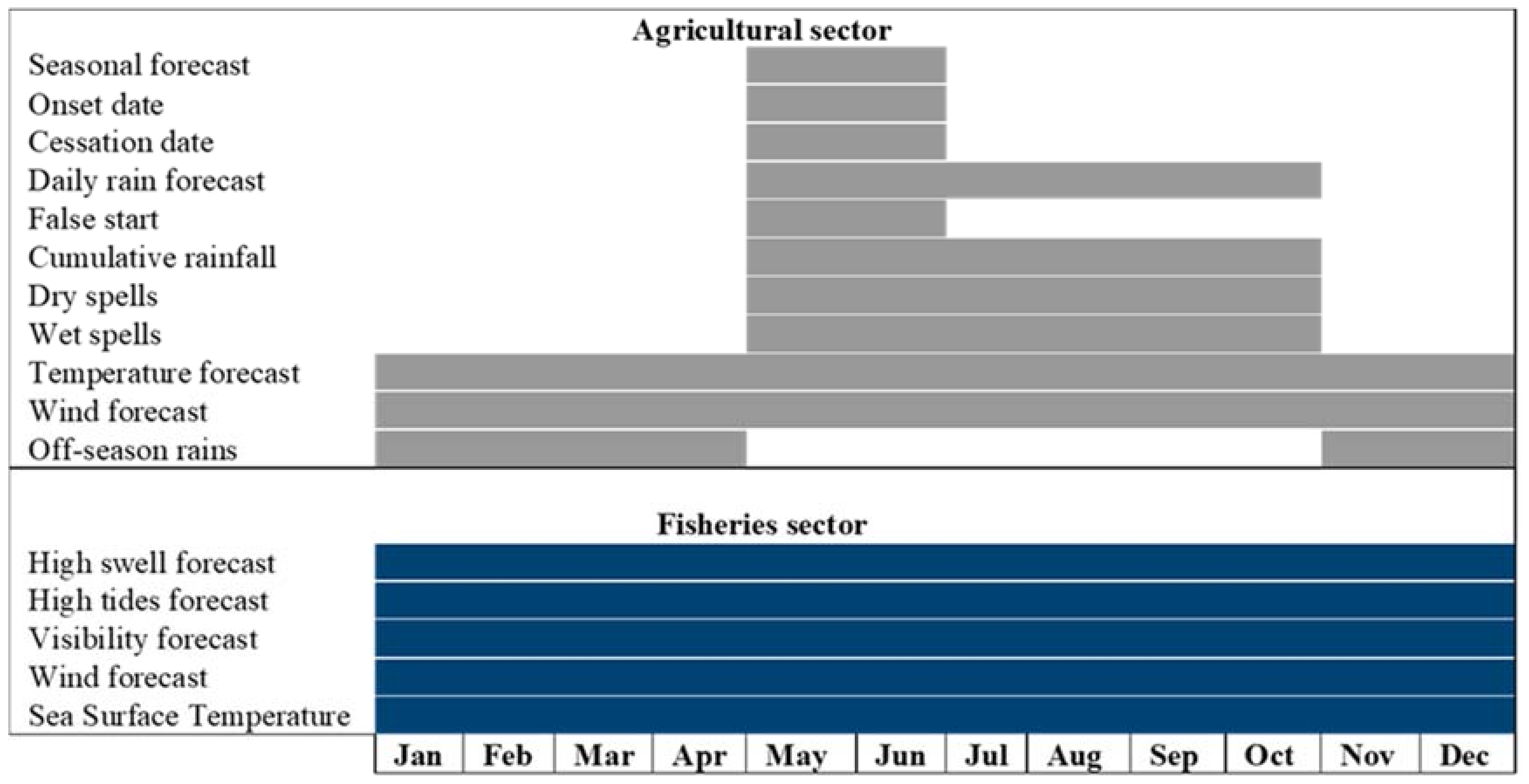
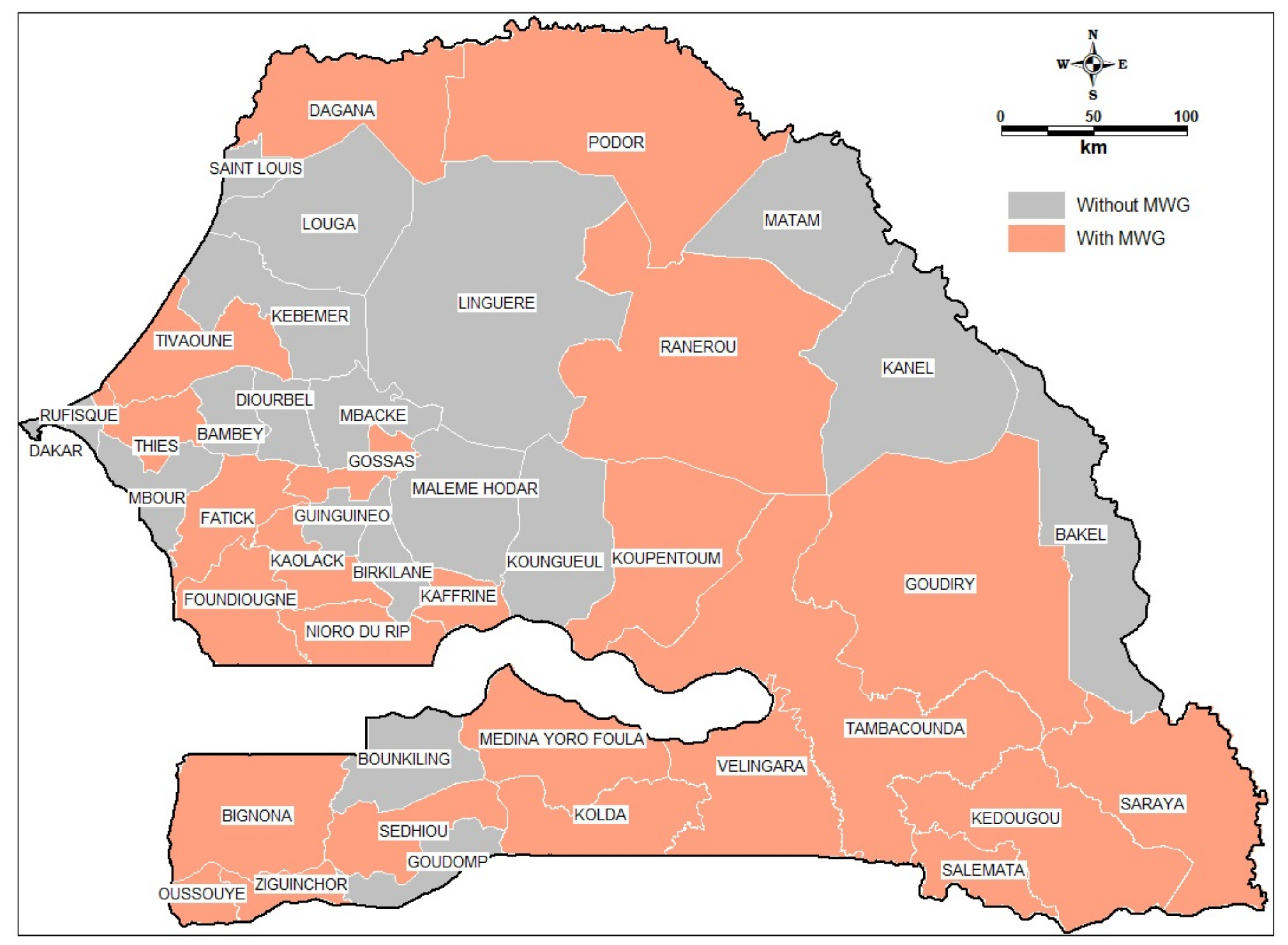
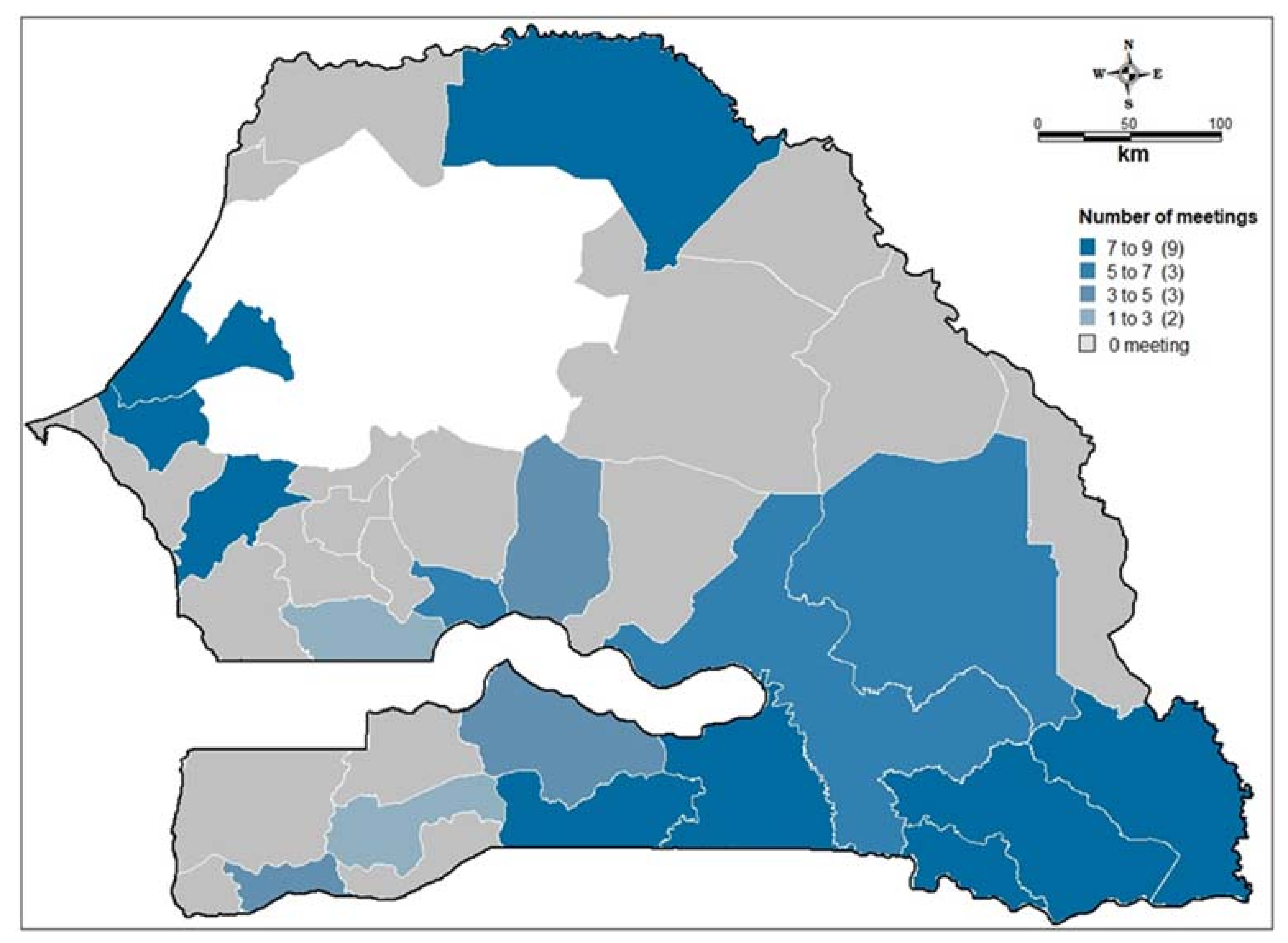
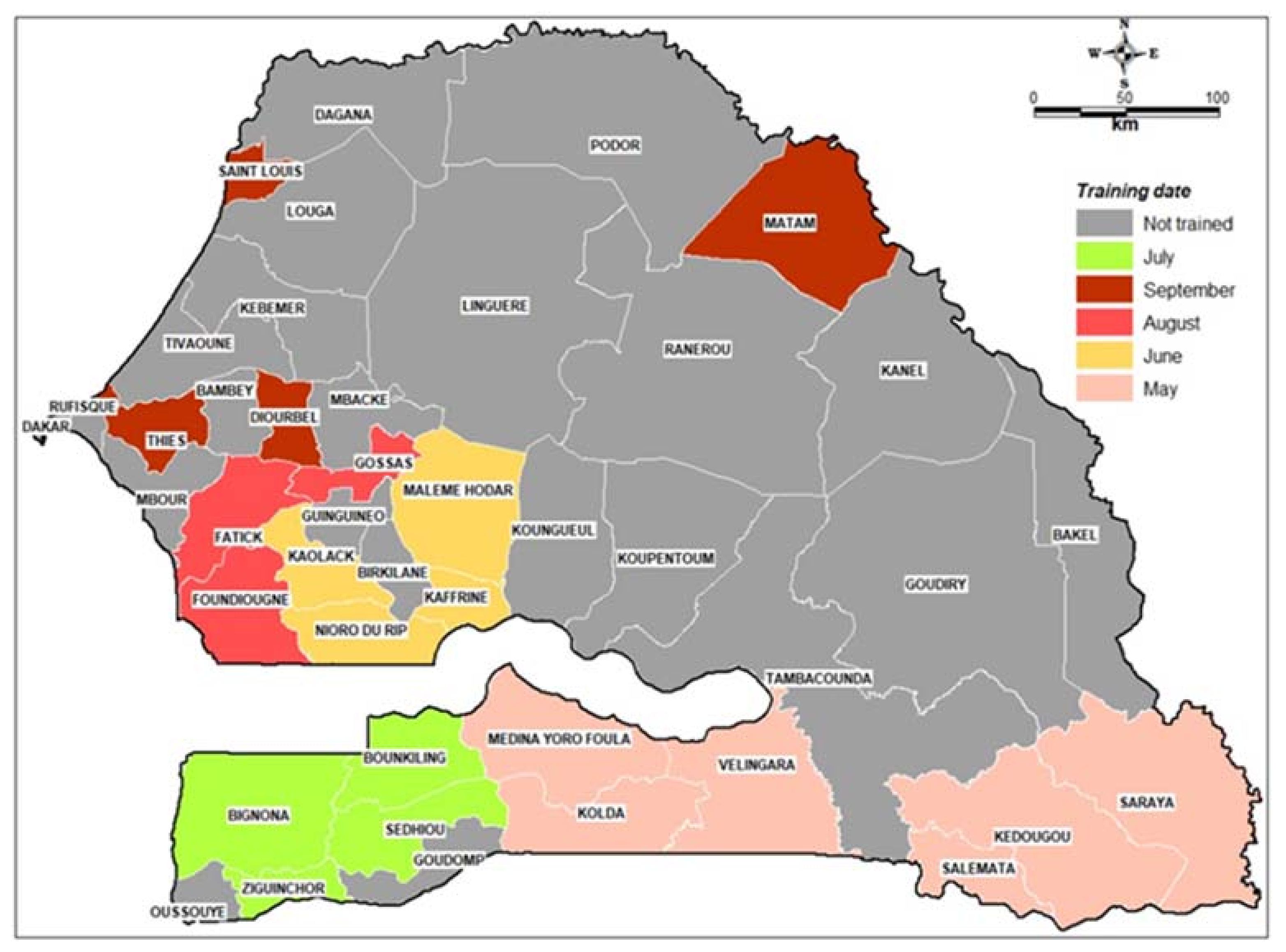
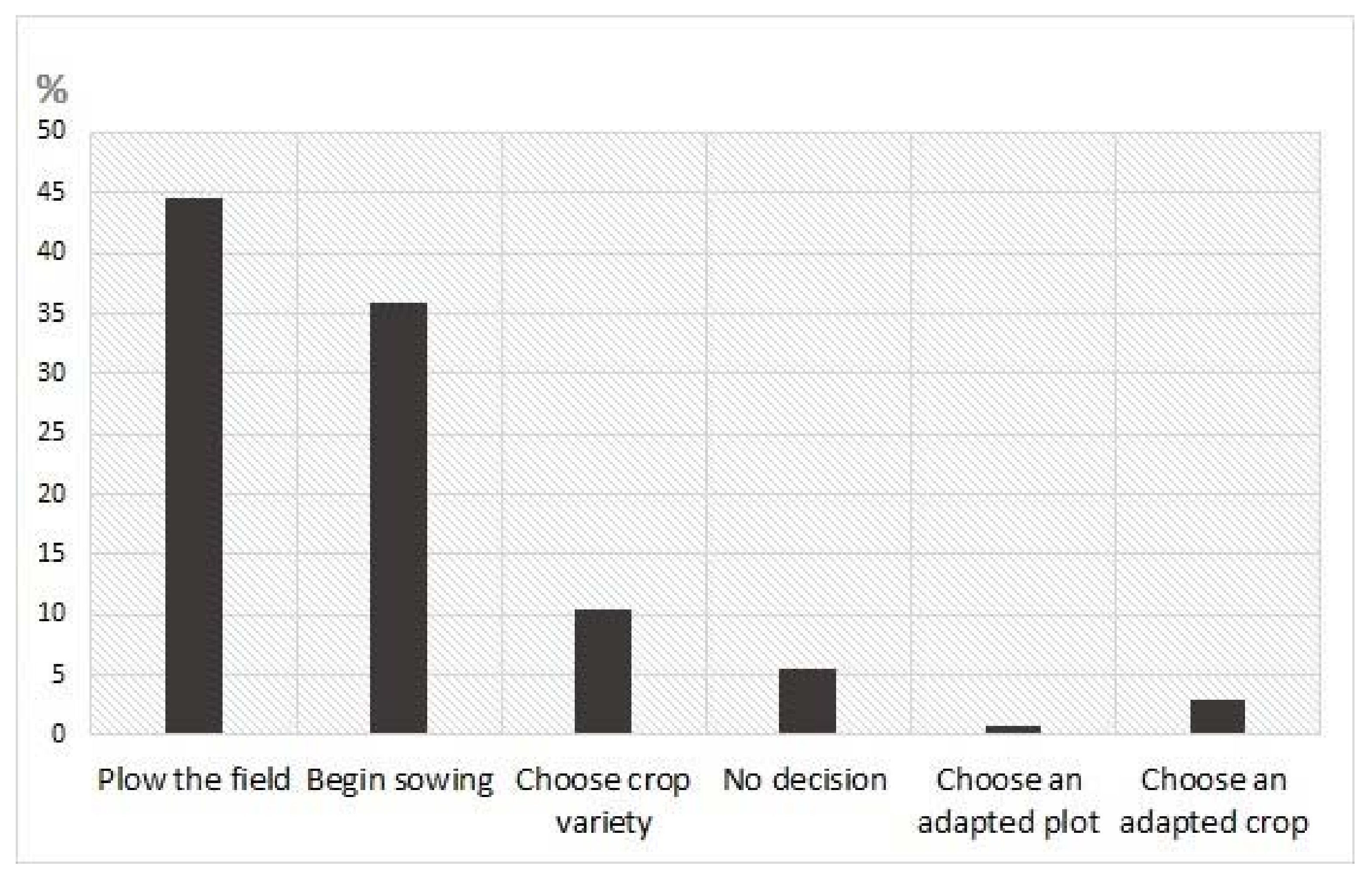
| Rank | Requested CIS | Timing | Frequency | Spatial Resolution |
|---|---|---|---|---|
| Agricultural Sector | ||||
| 1 | Seasonal forecast | May–June | Once a year | Local and regional |
| 2 | Onset date | May | Once a year | Local and regional |
| 3 | Cessation date | May | Once a year | Local and regional |
| 4 | Optimal sowing date | May–June | Once a year | Local and regional |
| 5 | Daily rain forecast | May–Sept | Daily | Local and regional |
| 6 | False start | May–June | When relevant | Local and regional |
| 7 | Cumulative rainfall | May–Sept | Decadal | Local and regional |
| 8 | Dry spells | May–Sept | Decadal | Local and regional |
| 9 | Wet spells | May–Sept | Decadal | Local and regional |
| 10 | Moisture | May–Sept | Decadal | Local and regional |
| 11 | Temperature forecast | May–Sept | Daily | Local and regional |
| 12 | Wind forecast | May–Sept | Daily | Local and regional |
| 13 | Evapotranspiration (ETP) | May–Sept | Decadal | Local and regional |
| 14 | Insolation | May–Sept | Daily | Local and regional |
| 15 | Off-season rains | Sept–Oct | When relevant | Local and regional |
| 16 | On-farm forecast | May–Sept | Daily | Local |
| Livestock Management Sector | ||||
| 1 | Fodder availability | Year-round | Decadal | Regional and national |
| 2 | Water resource availability | Year-round | Decadal | Regional and national |
| 3 | Potential lightning zones | May–Sept | Daily | Local |
| 4 | Potential diseases occurrence zones | Year-round | Decadal | Regional and national |
| 5 | Transhumance corridors | Year-round | Decadal | Regional and national |
| Fisheries Sector | ||||
| 1 | High swell forecast | Year-round | daily | Costal zones |
| 2 | High tides forecast | Year-round | daily | Costal zones |
| 3 | Visibility forecast | Year-round | daily | Costal zones |
| 4 | Wind forecast | Year-round | daily | Costal zones |
| 5 | Potential lightning zones | Year-round | daily | Costal zones |
| 6 | Sea Surface Temperature | Year-round | daily | Costal zones |
| Identified CIS Diffusion Channels | Operational | Beneficiaries | Strengths | Weaknesses |
|---|---|---|---|---|
| Community radios | YES | All users | Accessible Local language | Weak coverage |
| Televisions Communication screen (ports) | YES NO | All users Fishermen | Visual information | Weak coverage |
| Mobile devices: SMS Vocal message in local language USSD Mobile application (Meteo Senegal) | YES YES NO YES | All users | Targeted information, Interactive | Not accessible to all beneficiaries |
| Emails | YES | Technical services, Radios, Officials Producers group | Easy to understand Interactive | Limited access |
| Website (www.ANACIM.sn) | YES | All users | Accessible Full information | Lack of accuracy Limited access |
| Call service | YES | All users | Interactive, direct feedback | Only one line Very crowded |
| Itinerant Seminars | YES | All users | Interactive | Costly and sporadic |
| Regions | District | Localities | Technical Services | Fishermen | Media | ||
|---|---|---|---|---|---|---|---|
| Services | Participants | Male | Female | ||||
| Ziguinchor | Oussouye | Oukoute | 5 | 5 | 20 | 2 | 3 |
| Ziguinchor | Oussouye | Elinkine | 3 | 4 | 29 | 1 | 0 |
| Ziguinchor | Oussouye | Diogué | 3 | 4 | 37 | 2 | 0 |
| Ziguinchor | Bignona | Mangagoulack | 7 | 7 | 37 | 3 | 2 |
| Ziguinchor | Bignona | Thiobon | 5 | 5 | 40 | 2 | 1 |
| Ziguinchor | Bignona | Kalounayes | 7 | 7 | 40 | 1 | 1 |
| Fatick | Fatick | Djiffer | 3 | 8 | 32 | 3 | 1 |
| Fatick | Foundiougne | Foundiougne | 3 | 5 | 38 | 1 | 1 |
| Ziguinchor | Ziguinchor | Ziguinchor | 2 | 16 | 37 | 0 | 3 |
| Ziguinchor | Bignona | Kafountine | 2 | 2 | 37 | 1 | 0 |
| Total | 40 | 63 | 348 | 16 | 12 | ||
© 2018 by the authors. Licensee MDPI, Basel, Switzerland. This article is an open access article distributed under the terms and conditions of the Creative Commons Attribution (CC BY) license (http://creativecommons.org/licenses/by/4.0/).
Share and Cite
Ouedraogo, I.; Diouf, N.S.; Ouédraogo, M.; Ndiaye, O.; Zougmoré, R.B. Closing the Gap between Climate Information Producers and Users: Assessment of Needs and Uptake in Senegal. Climate 2018, 6, 13. https://doi.org/10.3390/cli6010013
Ouedraogo I, Diouf NS, Ouédraogo M, Ndiaye O, Zougmoré RB. Closing the Gap between Climate Information Producers and Users: Assessment of Needs and Uptake in Senegal. Climate. 2018; 6(1):13. https://doi.org/10.3390/cli6010013
Chicago/Turabian StyleOuedraogo, Issa, Ndeye Seynabou Diouf, Mathieu Ouédraogo, Ousmane Ndiaye, and Robert B. Zougmoré. 2018. "Closing the Gap between Climate Information Producers and Users: Assessment of Needs and Uptake in Senegal" Climate 6, no. 1: 13. https://doi.org/10.3390/cli6010013
APA StyleOuedraogo, I., Diouf, N. S., Ouédraogo, M., Ndiaye, O., & Zougmoré, R. B. (2018). Closing the Gap between Climate Information Producers and Users: Assessment of Needs and Uptake in Senegal. Climate, 6(1), 13. https://doi.org/10.3390/cli6010013





